12 DIY Vertical Vegetable Garden Ideas That Are Good Enough to Eat
Have your dream garden and eat it too


Vertical vegetable gardens are a tale as old as time—or more precisely, a tale at least as old as 3000 B.C. This type of gardening has actually been found in ancient cities like Babylon and Machu Picchu, but there’s a reason this old classic has stuck around.
Vertical gardening (including DIY vertical succulent gardens) lets you grow a lot in a small space, making it ideal for apartment dwellers and homeowners without large backyards. It’s also not hard to DIY, whether you choose a hydroponics kit or get your hands dirty. Want to get started? These DIY vertical vegetable garden ideas will help you plan your perfect veggie garden.
1. Turn Shoe Organizers Into a Living Wall
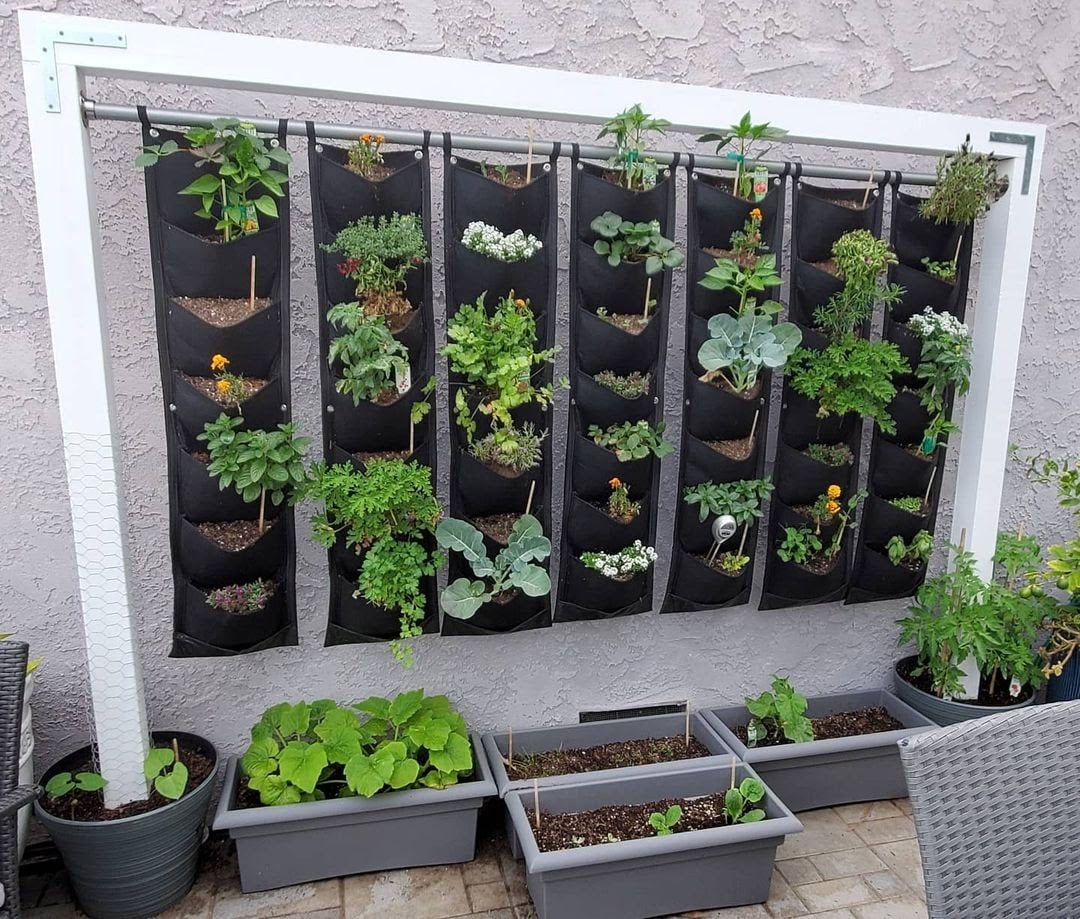
Gardening can be tough, but you’ve got this vertical garden in the bag—literally. Use grow bags or shoe organizers (yes, the same shoe organizers in your closet) to create a lush, edible wall like Melanie Collup.
All you need is a curtain rod and a place to hang them. Make sure you choose bags made from a breathable, porous material. Drainage is key when you’re growing vegetables in containers.
2. Make a DIY Vertical Vegetable Garden From Shipping Pallets
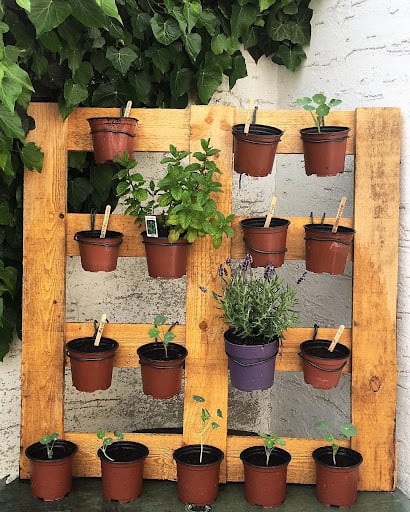
This upcycle is one of the most popular vertical vegetable garden ideas, and for good reason. It’s an ideal entry-level project for those new to vertical gardening.
Though there are variations on DIY pallet garden beds, they all start with an old shipping pallet (like this one from Instagram user @sunflowers.and.stars). Refinish it in your stain of choice, then use wire to make hangers for your pots.
3. Take Your Vertical Veggie Garden Indoors With a Hydroponics Kit
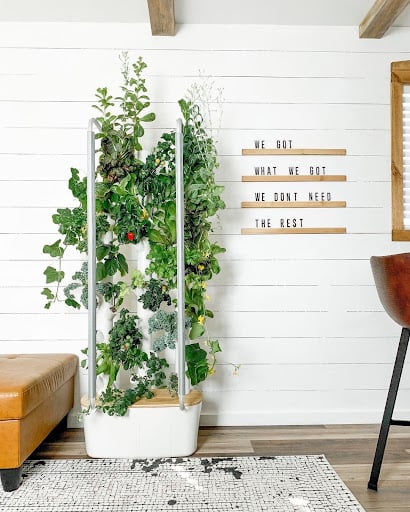
Looking to grow veggies indoors? If you want the type of edible living wall you see in luxury office buildings or trendy restaurants, you’ll have to bring in a top-rated landscaper who specializes in hydroponics.
To get the look for less, you can DIY it with a vertical veggie garden kit, like this one from blogger Hannah Hathaway. Veggies need a lot of light if you’re gardening indoors, so look for one that comes with grow lights to get the best results.
4. Transform Your Staircase Railing Into a Vertical Veggie Garden
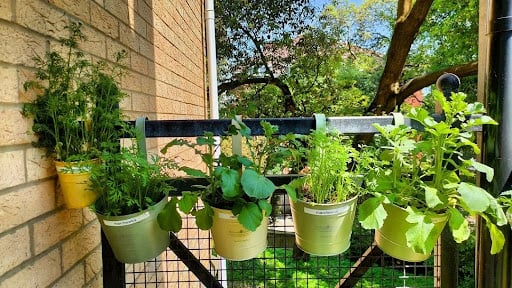
Sometimes, you’ve only got a balcony to work with, but that’s still enough room for a vertical garden like this one by Instagram user Agnes Krol. The railing is an underutilized space.
Line it with hanging planters filled with small veggies and herbs that you can bring inside during the winter for a year-round garden. If you want your balcony to look extra lush, lace viney veggies up the staircase (just don’t put them where you actually walk or you might trip).
5. Hang Pots to Save Space
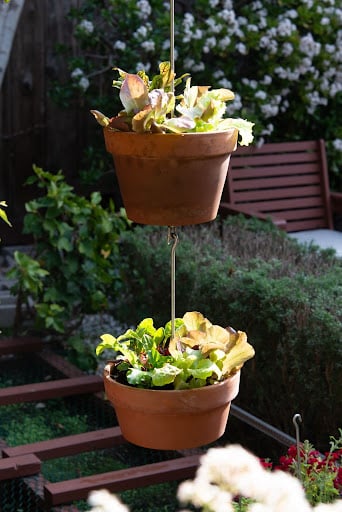
If you want a space-saving vertical garden, stack your terracotta pots—you just need the right hanging mechanism for your planter. Ryan Benoit, CEO of Sky Pots, mastered this DIY with his 3D printer, but you can get the same look at home without the tech.
The simplest way is to hook two macrame hanging planters together using an S-hook. You can also drill two holes on the bottom of a hanging terracotta pot. Thread heavy-duty wire through the holes, twist the wire into a hanger, and use it to hang another planter. This method works best for lightweight plants like herbs, alpine strawberries, and snap peas.
6. Keep Your Greens on the Fence
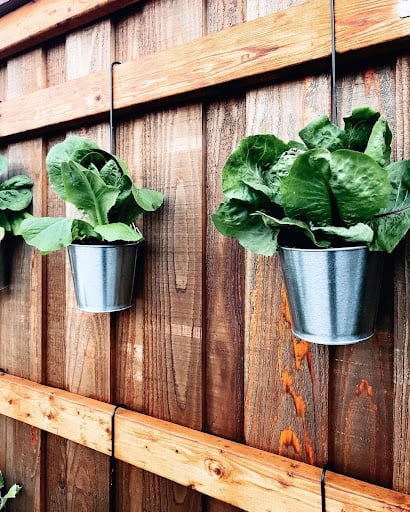
Looking for a simple vertical garden DIY? With a few hooked pots, your fence can become a vertical planter like this one from The Kiwi Home. If it seems like your backyard veggie garden won’t get a lot of sun, opt for leafy greens like Swiss chard or New Zealand spinach.
They tolerate shade better than root or fruit-bearing vegetables (though they’ll still need about six hours of sunshine for an optimal harvest).
7. Balance Out Beans With a Vertical Planter
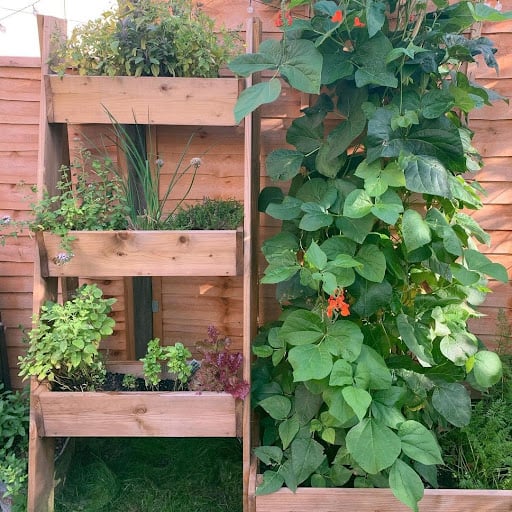
When you’re planning your veggie garden, it’s important to think about balance. Most vertical vegetable garden ideas focus on small plants—but those plants eventually grow. For example, bean plants love to climb and will quickly take over a bean pole or trellis.
This can visually overwhelm your smaller plants. Instead, balance out your tall and bushy veggies by putting smaller plants in a vertical planter like this DIY plant ladder by Richmond Renovation.
8. Shoot for the Rainbow
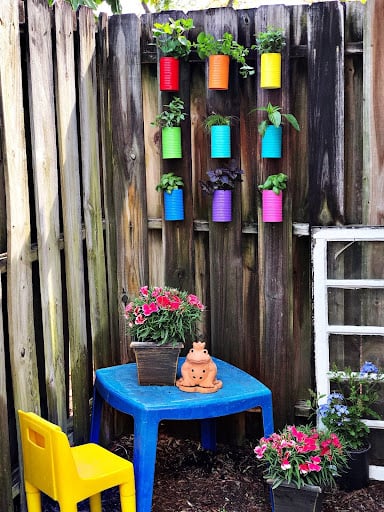
Add some color to your vertical garden with a rainbow of recycled can planters. For this DIY, paint old soup, vegetable, or coffee cans with outdoor patio paint before screwing them into a wall or fence.
Beth Watson, who created the craft for her blog Creatively Beth, believes the brighter, the better. “Rainbow is my favorite color, so I selected a bright and colorful palette,” she said.
9. Give Your Vertical Vegetable Garden Room to Grow With Metal Racks
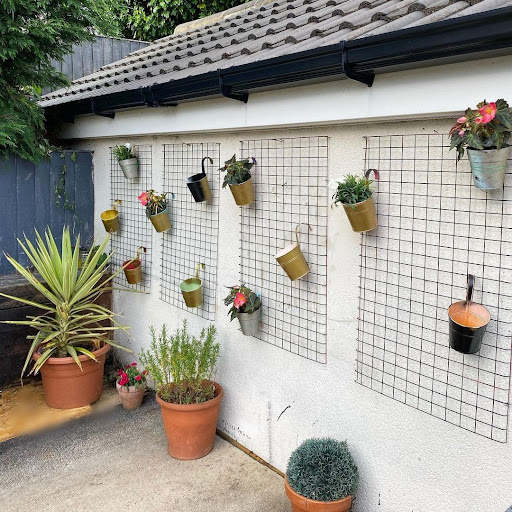
You can create this DIY vertical gardening idea from Angie Talbot Interiors using items that are probably already lying around in your garage. All you need are a couple wire racks, some hanging planters, and a place to put them. For an added bonus, plant vining vegetables—like climbing tomatoes or malabar spinach—in large planters along the bottom of your vertical garden. They’ll use the racks above like a trellis and climb.
10. Spruce Up an Old Cinder Block Wall
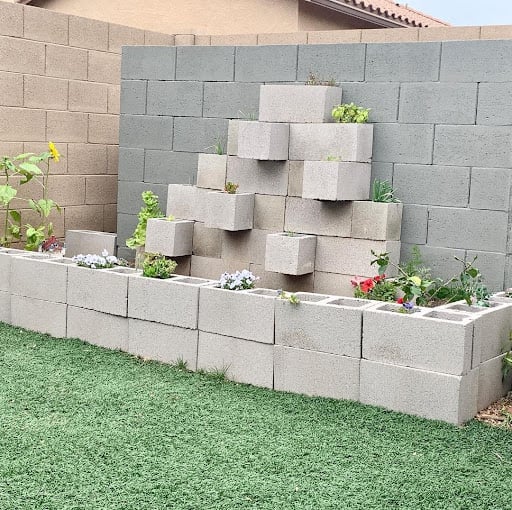
Who knew cinder block was so stylish? This industrial take on a DIY vertical vegetable garden from White Desert Farmhouse is perfect for smaller plants like peas and peppers. Just stack the cinder blocks and fold metal mesh to create a planter inside. Line your wire planter with weed cloth to prevent the soil from falling out the bottom, then get gardening.
11. Put Your Vertical Garden in the Gutter
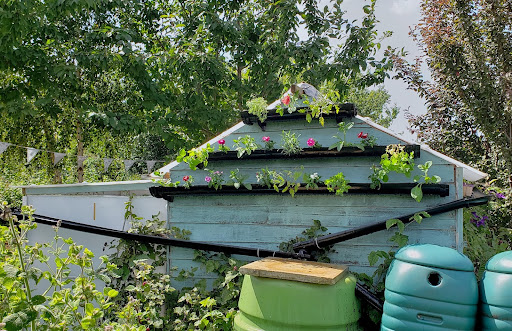
If animals keep eating your veggies, it’s time to look up. A vertical veggie garden—like this one from Alice Whitehead—uses gutter pipes as planters to keep vegetables away from rabbits, deer, and other critters looking for a quick meal. Since this might be a complicated DIY for someone with no experience, there’s no shame in hiring a gutter contractor to help you.
12. Upcycle Your Bed Springs
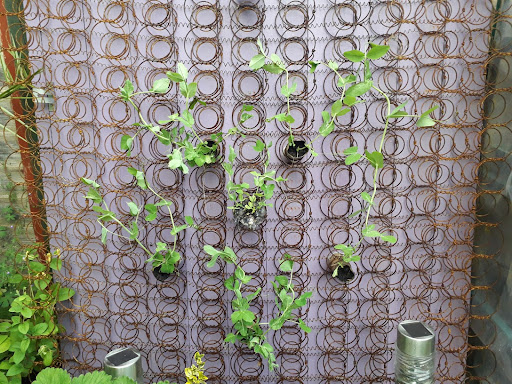
One person’s trash is another person’s treasure. That’s exactly the thought behind this upcycled vertical vegetable garden idea. Dave Poulton, who's behind the UK-based community project Up The Garden Bath, quite literally sprung into action when he found an old mattress dumped behind his home.
He dismantled the mattress, mounted the springs on wood, and stuck planters in the springs. The springs act as a trellis, so the more viney veggies you plant, the fuller it will look.



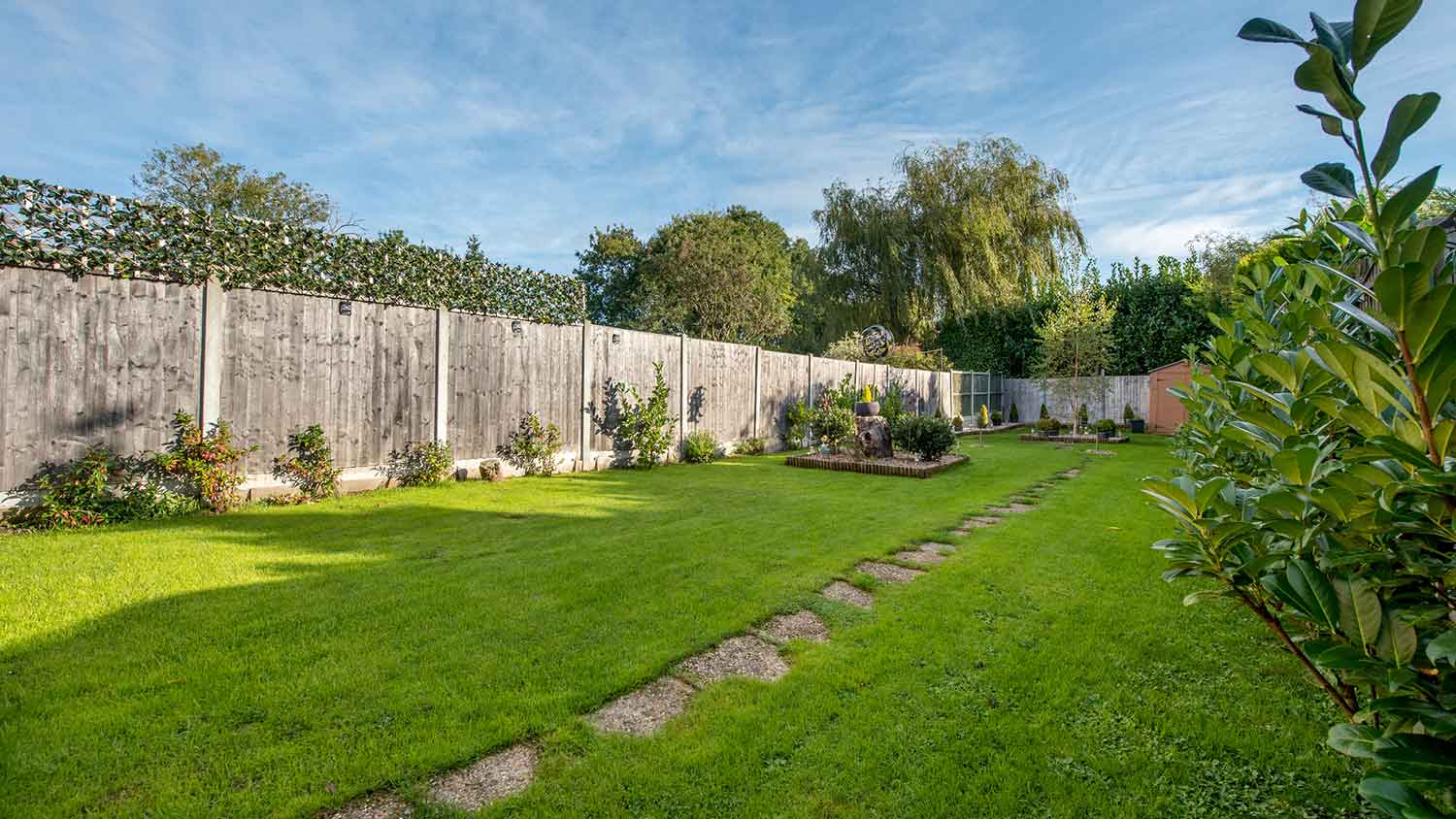

- 14 Creative Home Garden Ideas That Inspire
- 11 Tips for Creating a Bountiful Backyard Garden
- Go From Can’t to Plant With These 10 Vertical Succulent Garden Ideas
- Balcony Planting Ideas: 7 Ways to Start a Garden in a Small Space
- 28 Small Backyard Ideas: Make the Most of Your Yard
- 9 Garden Styles to Inspire Your Outdoor Sanctuary
- Plants That Attract Beneficial Pests, From Honeybees to Ladybugs
- 7 Small Patio Ideas That Will Maximize Your Outdoor Space
- 13 Essential Landscaping Tips for a Beautiful Spring Garden
- 8 Common Pollinators in Your Vegetable Garden










